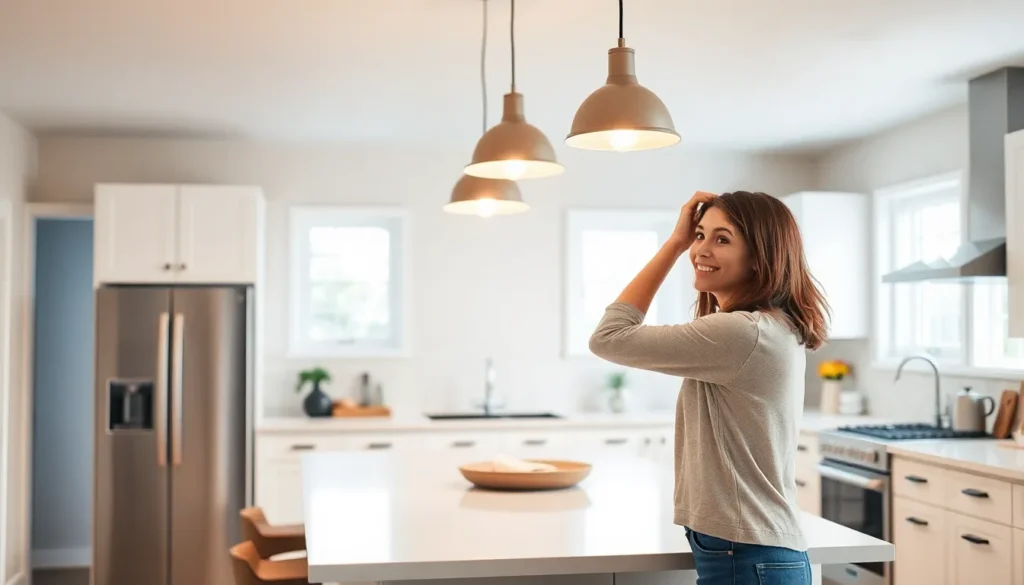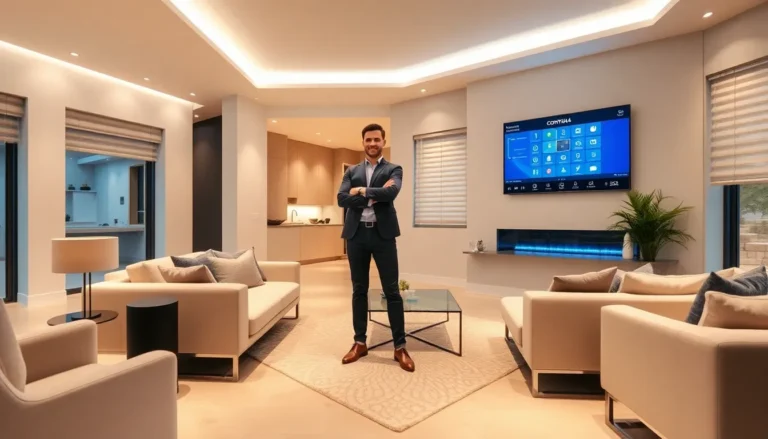Table of Contents
ToggleIn the world of home renovation, lighting is often the unsung hero. It’s like the secret sauce that turns a bland dish into a gourmet meal. Without the right layout, even the most stunning spaces can feel drab and uninviting. Imagine stepping into a beautifully renovated kitchen only to feel like you’re in a dimly lit cave. Not ideal, right?
Understanding Renovation Lighting Layout
Lighting significantly impacts the ambiance and functionality of a renovated space. Attention to lighting layout can transform any area, enhancing both aesthetics and usability.
Importance of Proper Lighting
Proper lighting serves multiple purposes in a home. It not only complements the interior design but also enhances safety and visibility. Bright, evenly distributed light makes tasks easier, such as cooking or reading. Insufficient lighting can create shadows and highlight unwanted aspects of a room, detracting from the design. It contributes to mood and atmosphere, allowing homeowners to create a welcoming environment. Selecting adequate fixtures ensures that light enhances the overall aesthetic while fulfilling practical needs.
Key Elements of Lighting Design
Several elements comprise effective lighting design. Ambient lighting provides general illumination, creating a comfortable atmosphere throughout the space. Task lighting focuses on specific areas, making activities like cooking or studying more efficient. Accent lighting highlights particular features or décor, drawing attention to artwork, plants, or architectural details. Choosing the right fixtures involves balancing light color, intensity, and placement. Incorporating dimmers adds flexibility, allowing users to adjust the brightness based on the time of day or occasion. Each element plays a crucial role in achieving a cohesive and visually appealing lighting layout.
Types of Lighting Styles

Different lighting styles greatly affect the renovation outcome, shaping mood and functionality. Understanding each type helps achieve a balanced and inviting environment.
Ambient Lighting
Ambient lighting serves as the primary source of illumination in a space. This type creates a uniform glow that ensures even light distribution, making rooms feel bright and welcoming. Methods to achieve ambient lighting include using ceiling-mounted fixtures, wall sconces, or recessed lighting. Selecting warm LED bulbs enhances comfort, complementing the overall design. Consider adjustable options to control brightness levels, providing flexibility for various activities.
Task Lighting
Task lighting focuses on specific areas where activities like reading, cooking, or working occur. Fixtures such as under-cabinet lights, desk lamps, and pendant lights effectively target these zones. Positioning task lights strategically helps minimize shadows and enhances visibility in work areas. Choosing adjustable models allows users to direct light precisely where needed, increasing functionality. Employing bright, energy-efficient bulbs can improve productivity while reducing energy consumption.
Accent Lighting
Accent lighting highlights architectural features and decorative elements in a room. This style draws attention to artworks, sculptures, or textured walls, creating visual interest. Common methods include track lighting, spotlights, or wall-mounted fixtures. Thoughtful placement can transform ordinary spaces into captivating focal points. Using dimmable options provides versatility, allowing for changes in ambiance depending on the occasion. Selecting warm hues adds warmth and enhances the overall aesthetic of the renovation.
Planning Your Renovation Lighting Layout
Effective lighting enhances the ambiance and functionality of a renovated space. Strategic planning can transform a room, ensuring it meets practical needs while providing aesthetic appeal.
Assessing Your Space
Start by analyzing the dimensions and layout of each room. Evaluate natural light sources, noting how different times of day affect brightness. Identify focal points, such as artwork or architectural features, that require accent lighting. Consider existing furniture arrangements; they influence the placement of task lighting. Account for activities in each space. For instance, kitchens benefit from task lighting over countertops, while living rooms thrive under ambient and accent options.
Choosing the Right Fixtures
Select fixtures that match the style and purpose of the room. Pendant lights work well in dining areas, offering both task and ambient illumination. Use recessed lighting in kitchens and hallways for a clean, modern look. Wall sconces can highlight artwork or architectural elements effectively. Incorporate dimmable options to allow flexibility in brightness, adapting the mood to different occasions. Prioritize energy-efficient bulbs, such as LEDs, which provide longevity while reducing electricity costs.
Common Mistakes to Avoid
Proper lighting enhances a space, yet several common mistakes can diminish its impact. Identifying these pitfalls helps ensure a successful renovation lighting layout.
Overlighting vs. Underlighting
Overlighting results in bright, harsh environments that cause discomfort. Excessive use of fixtures can create glare and shadows in unexpected areas. Balancing brightness with functionality prevents overwhelming illumination. Underlighting, conversely, leads to dark, uninviting spaces. Insufficient light levels may hinder tasks and negatively affect mood. Achieving a harmonious blend of ambient, task, and accent lighting prevents both extremes and enhances aesthetics.
Ignoring Room Functionality
Room functionality plays a crucial role in lighting layout decisions. Failing to consider how each area will be used leads to ineffective lighting placements. Kitchens, for example, require focused task lighting for cooking activities. Living rooms benefit from softer ambient lighting for relaxation and socialization. Each space presents unique needs, from reading nooks to workspace areas. Understanding these requirements helps in selecting appropriate fixtures and layouts.
Effective renovation lighting layout transforms spaces into inviting and functional areas. By thoughtfully combining ambient, task, and accent lighting, homeowners can create a harmonious atmosphere that enhances both aesthetics and usability.
Selecting the right fixtures and ensuring proper placement is essential for achieving desired effects. Incorporating dimmable options adds flexibility while energy-efficient bulbs contribute to long-term savings.
Avoiding common pitfalls like overlighting and underlighting ensures that each room feels balanced and welcoming. With careful planning and attention to detail, lighting can truly elevate any renovation project.







